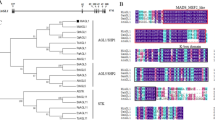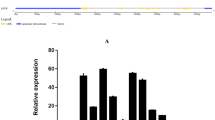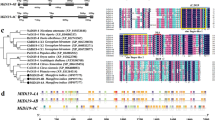Abstract
In order to ascertain the regulatory mechanism of fruit development in Isatis indigotica Fortune, the complementary DNA (cDNA) sequence of the SHATTERPROOF 2 (SHP2) orthologous gene was identified by Rapid Amplification of cDNA Ends technology and the corresponding gene was named IiSHP2. The expression pattern of IiSHP2 was determined by quantitative reverse transcription-polymerase chain reaction and wild-type Col-0 Arabidopsis plants were transformed with the IiSHP2 gene using Agrobacterium tumefaciens and the floral-dip method. Expression analyses indicated that IiSHP2 was highly expressed in flowers, silicles and seeds. Compared to wild-type plants, IiSHP2 transgenic lines bolted earlier. Detailed phenotypic observations showed that the size of the rosette and cauline leaves in transgenic lines was reduced and the cauline leaves of the transgenic lines were incurved and displayed a funnel-like shape. During the reproductive growth stage, IiSHP2 transgenic plants produced shortened sepals and the flower buds were not encapsulated completely. Moreover, the petals of the transgenic lines were converted into stamineous tissues, accompanied by exposed stamens, short malformed siliques and wrinkled valves, indicating a severe decline in fertility. These experimental conclusions are valuable as a reference for the breeding of medicinal plants.










Similar content being viewed by others
References
APG (2003) An update of the Angiosperm Phylogeny Group classification for the orders and families of flowering plants: APG II. Bot J Linn Soc 141:399–436
Battaglia R, Brambilla V, Colombo L, Stuitje AR, Kater MM (2006) Functional analysis of MADS-box genes controlling ovule development in Arabidopsis using the ethanol-inducible alc gene-expression system. Mech Dev 123:267–276
Brambilla V, Battaglia R, Colombo M, Masiero S, Bencivenga S, Kater MM, Colombo L (2007) Genetic and molecular interactions between BELL1 and MADS box factors support ovule development in Arabidopsis. Plant Cell 19:2544–2556
Chen YY, Lee PF, Hsiao YY, Wu WL, Pan ZJ, Lee YI, Liu KW, Chen LJ, Liu ZJ, Tsai WC (2012) C- and D-class MADS-box genes from Phalaenopsis equestris (Orchidaceae) display functions in gynostemium and ovule development. Plant Cell Physiol 53:1053–1067
Clough SJ, Bent AF (1998) Floral dip: a simplified method for Agrobacterium-mediated transformation of Arabidopsis thaliana. Plant J 16:735–743
Colombo M, Brambilla V, Marcheselli R, Caporali E, Kater MM, Colombo L (2010) A new role for the SHATTERPROOF genes during Arabidopsis gynoecium development. Dev Biol 337:294–302
Ehlers K, Bhide AS, Tekleyohans DG, Wittkop B, Snowdon RJ, Becker A (2016) The MADS box genes ABS, SHP1, and SHP2 are essential for the coordination of cell divisions in ovule and seed coat development and for endosperm formation in Arabidopsis thaliana. PLoS ONE 11:e0165075
Favaro R, Pinyopich A, Battaglia R, Kooiker M, Borghi L, Ditta G, Yanofsky MF, Kater MM, Colombo L (2003) MADS-box protein complexes control carpel and ovule development in Arabidopsis. Plant Cell 15:2603–2611
Ferrándiz C, Liljegren SJ, Yanofsky MF (2000) Negative regulation of the SHATTERPROOF genes by FRUITFULL during Arabidopsis fruit development. Science 289:436–438
Flanagan CA, Hu Y, Ma H (1996) Specific expression of the AGL1 MADS-box gene suggests regulatory functions in Arabidopsis gynoecium and ovule development. Plant J 10:343–353
Fornara F, de Montaigu A, Coupland G (2010) SnapShot: control of flowering in Arabidopsis. Cell 141:550.e1–550.e2
Goodrich J, Puangsomlee P, Martin M, Long D, Meyerowitz EM, Coupland G (1997) A Polycomb-group gene regulates homeotic gene expression in Arabidopsis. Nature 386:44–51
Hong JK, Kim SY, Kim KS, Kwon SJ, Kim JS, Kim JA, Lee SI, Lee YH (2013) Overexpression of a Brassica rapa MADS-box gene, BrAGL20, induces early flowering time phenotypes in Brassica napus. Plant Biotechnol Rep 7:231–237
Jack T, Sieburth L, Meyerowitz E (1997) Targeted misexpression of AGAMOUS in whorl 2 of Arabidopsis flowers. Plant J 11:825–839
Kater MM, Dreni L, Colombo L (2006) Functional conservation of MADS-box factors controlling floral organ identity in rice and Arabidopsis. J Exp Bot 57:3433–3444
Kord H, Shakib AM, Daneshvar MH, Azadi P, Bayat V, Mashayekhi M, Zarea M, Seifi A, Ahmad-Raji M (2015) RNAi-mediated down-regulation of SHATTERPROOF gene in transgenic oilseed rape. 3 Biotech 5:271–277
Kotoda N, Wada M, Kusaba S, Kano-Murakami Y, Masuda T, Soejima J (2002) Overexpression of MdMADS5, an APETALA1-like gene of apple, causes early flowering in transgenic Arabidopsis. Plant Sci 162:679–687
Kramer EM, Jaramillo MA, Di Stilio VS (2004) Patterns of gene duplication and functional evolution during the diversification of the AGAMOUS subfamily of MADS box genes in angiosperms. Genetics 166:1011–1023
Krizek BA, Lewis MW, Fletcher JC (2006) RABBIT EARS is a second-whorl repressor of AGAMOUS that maintains spatial boundaries in Arabidopsis flowers. Plant J 45:369–383
Kumar S, Stecher G, Tamura K (2016) MEGA7: molecular evolutionary genetics analysis version 7.0 for bigger datasets. Mol Biol Evol 33:1870–1874
Liljegren SJ, Ditta GS, Eshed Y, Savidge B, Bowman JL, Yanofsky MF (2000) SHATTERPROOF MADS-box genes control seed dispersal in Arabidopsis. Nature 404:766–770
Lü S, Du X, Lu W, Chong K, Meng Z (2007) Two AGAMOUS-like MADS-box genes from Taihangia rupestris (Rosaceae) reveal independent trajectories in the evolution of class C and class D floral homeotic functions. Evol Dev 9:92–104
Ma YQ, Li DZ, Zhang L, Li Q, Yao JW, Ma Z, Huang X, Xu ZQ (2017) Ectopic expression of IiFUL isolated from Isatis indigotica could change the reproductive growth of Arabidopsis thaliana. Plant Physiol Biochem 121:140–152
Mizukami Y, Ma H (1992) Ectopic expression of the floral homeotic gene AGAMOUS in transgenic Arabidopsis plants alters floral organ identity. Cell 71:119–131
Mizzotti C, Mendes MA, Caporali E, Schnittger A, Kater MM, Battaglia R, Colombo L (2012) The MADS box genes SEEDSTICK and ARABIDOPSIS Bsister play a maternal role in fertilization and seed development. Plant J 70:409–420
Mühlhausen A, Lenser T, Mummenhoff K, Theißen G (2013) Evidence that an evolutionary transition from dehiscent to indehiscent fruits in Lepidium (Brassicaceae) was caused by a change in the control of valve margin identity genes. Plant J 73:824–835
Murashige T, Skoog F (1962) A revised medium for rapid growth and bio assays with tobacco tissue cultures. Physiol Plant 15:473–497
Pinyopich A, Ditta GS, Savidge B, Liljegren SJ, Baumann E, Wisman E, Yanofsky MF (2003) Assessing the redundancy of MADS-box genes during carpel and ovule development. Nature 424:85–88
Rijpkema AS, Vandenbussche M, Koes R, Heijmans K, Gerats T (2010) Variations on a theme: changes in the floral ABCs in angiosperms. Semin Cell Dev Biol 21:100–107
Rodríguez-Cazorla E, Ortuño-Miquel S, Candela H, Bailey-Steinitz LJ, Yanofsky MF, Martínez-Laborda A, Ripoll JJ, Vera A (2018) Ovule identity mediated by pre-mRNA processing in Arabidopsis. PLoS Genet 14:e1007182
Smyth D (2000) A reverse trend--MADS functions revealed. Trends Plant Sci 5:315–317
Theissen G (2001) Development of floral organ identity: stories from the MADS house. Curr Opin Plant Biol 4:75–85
Thiruvengadam M, Chung IM, Yang CH (2012) Overexpression of Oncidium MADS box (OMADS1) gene promotes early flowering in transgenic orchid (Oncidium Gower Ramsey). Acta Physiol Plant 34:1295–1302
Wei B, Liu D, Guo J, Leseberg CH, Zhang X, Mao L (2013) Functional divergence of two duplicated D-lineage MADS-box genes BdMADS2 and BdMADS4 from Brachypodium distachyon. J Plant Physiol 170:424–431
Wu W, Chen F, **g D, Liu Z, Ma L (2012) Isolation and characterization of an AGAMOUS-like gene from Magnolia wufengensis (Magnoliaceae). Plant Mol Biol Rep 30:690–698
Acknowledgements
This work was supported by the National Natural Science Foundation of China (30870194, J1210063), the Research Project of Provincial Key Laboratory of Shaanxi (15JS111), and the Opening Foundation of Key Laboratory of Resource Biology and Biotechnology in Western China (Northwest University), Ministry of Education.
Author information
Authors and Affiliations
Corresponding author
Ethics declarations
Conflict of interest
The authors declare that they have no conflict of interest.
Additional information
Publisher's Note
Springer Nature remains neutral with regard to jurisdictional claims in published maps and institutional affiliations.
Electronic supplementary material
Below is the link to the electronic supplementary material.
Supplemental Fig.
1 The cDNA sequence of IiSHP2 and the amino acid sequence of the encoded product. (DOCX 16 kb)
Rights and permissions
About this article
Cite this article
Lu, MX., Li, DZ., Pu, ZQ. et al. Ectopic expression of IiSHP2 from Isatis indigotica Fortune, a PLE-lineage MADS-box gene, influences leaf, floral organ and silique morphology in Arabidopsis thaliana. Physiol Mol Biol Plants 26, 379–389 (2020). https://doi.org/10.1007/s12298-019-00745-6
Received:
Revised:
Accepted:
Published:
Issue Date:
DOI: https://doi.org/10.1007/s12298-019-00745-6




